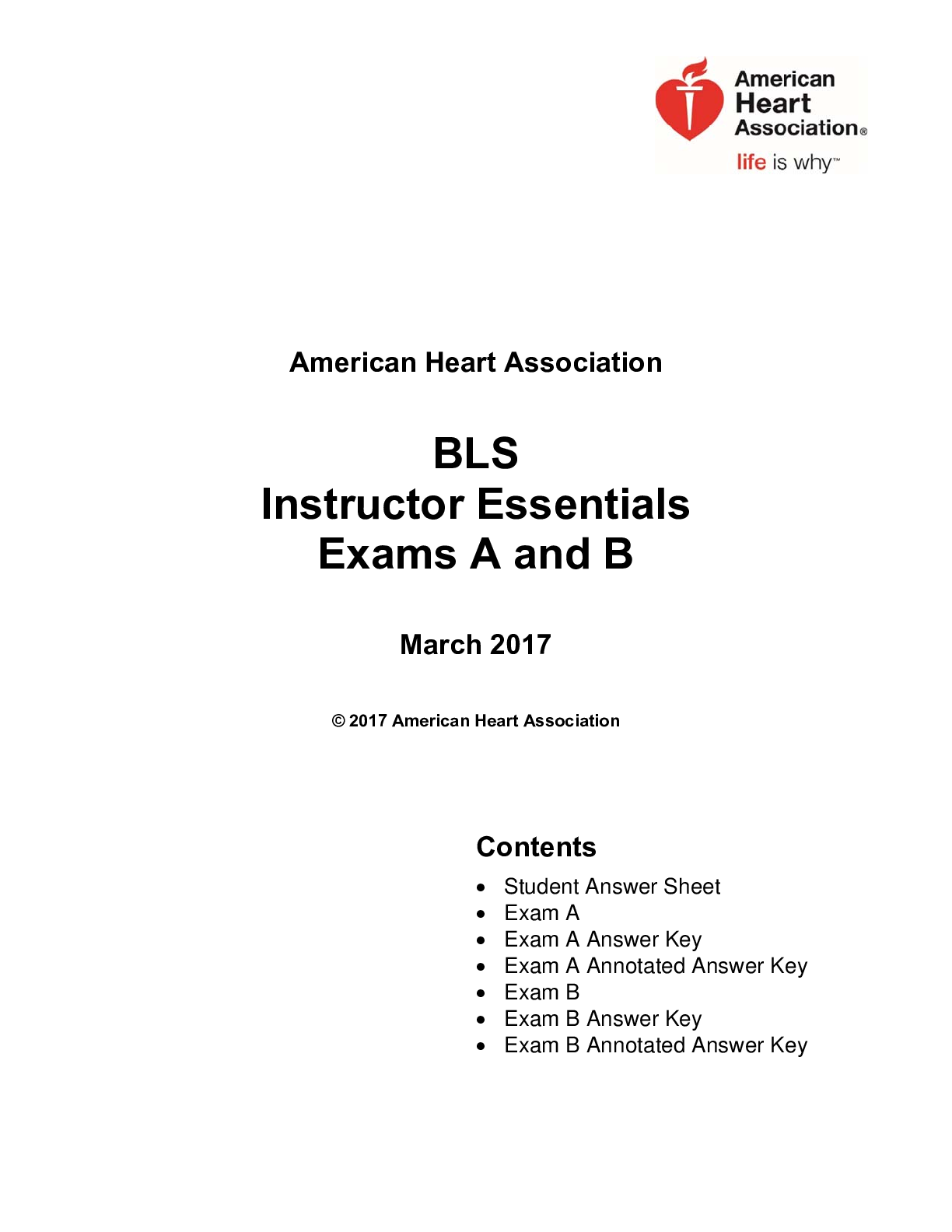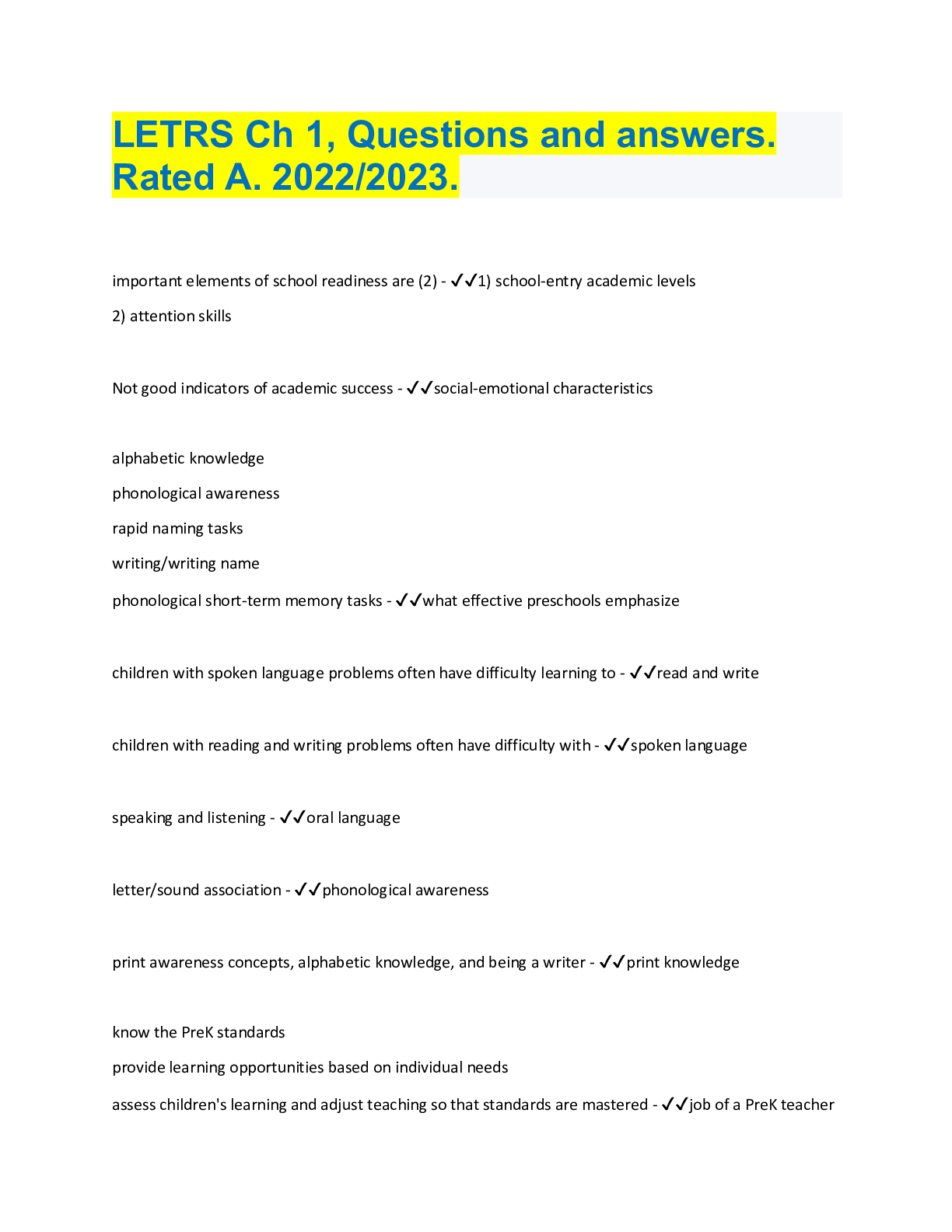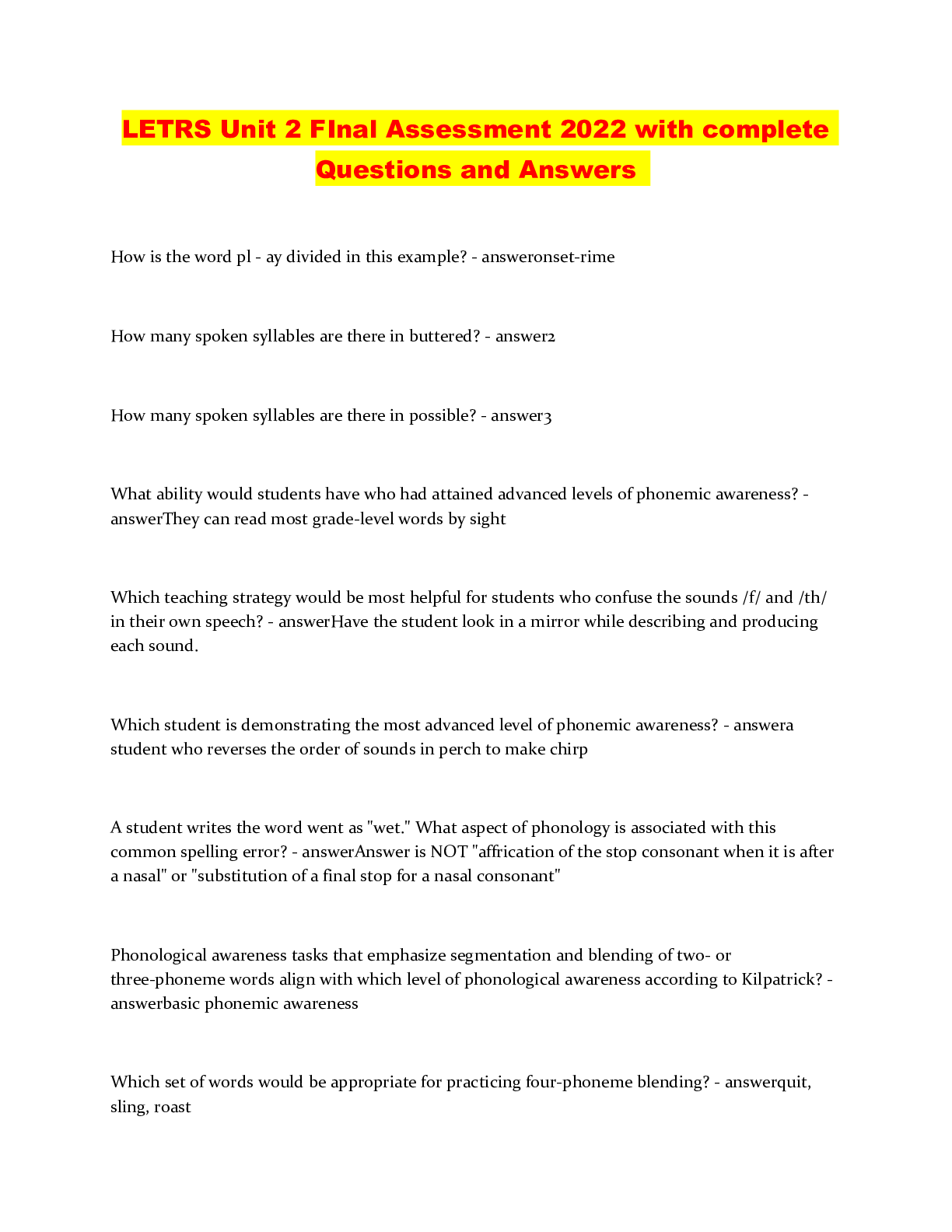*NURSING > QUESTIONS & ANSWERS > Latest Verified and Graded A NURS 6501 Advanced Pathophysiology Section 16 Questions and Answers at (All)
Latest Verified and Graded A NURS 6501 Advanced Pathophysiology Section 16 Questions and Answers at the bottom
Document Content and Description Below
16. Questions and Answers 1. Which of the following is not associated with esophageal webs? A. Plummer-Vinson syndrome B. Epidermolysis bullosa C. Lupus D. Psoriasis E. Stevens-Johnson synd... rome 2. An 11 year old boy complains that occasionally a bite of hotdog “gives mild pressing pain in his chest” and that “it takes a while before he can take another bite.” If it happens again, he discards the hotdog but sometimes he can finish it. The most helpful diagnostic information would come from A. Family history of Schatzki rings B. Eosinophil counts C. UGI D. Time-phased MRI E. Technetium 99 salivagram 3. 12 year old boy previously healthy with one-month history of difficulty swallowing both solid and liquids. He sometimes complains food is getting stuck in his retrosternal area after swallowing. His weight decreased approximately 5% from last year. He denies vomiting, choking, gagging, drooling, pain during swallowing or retrosternal pain. His physical examination is normal. What would be the appropriate next investigation to perform in this patient? A. Upper Endoscopy B. Upper GI contrast study C. Esophageal manometry D. Modified Barium Swallow (MBS) E. Direct laryngoscopy 4. A 12 year old male presents to the ER after a recent episode of emesis. The parents are concerned because undigested food 3 days old was in his vomit. He admits to a sensation of food and liquids “sticking” in his chest for the past 4 months, as he points to the upper middle chest. Parents relate a 10 lb (4.5 Kg) weight loss over the past 3 months. Past medical history and family history are unremarkable. Vital signs are stable, and physical exam is unremarkable. The ER physician obtains a chest X-ray AP and lateral that shows dilatation of the esophagus with an air fluid level. What is the best diagnostic test for this patient’s condition? A. Endoscopy B. 24 hour PH monitoring C. Barium swallow D. Esophageal manometry 626 The NASPGHAN Fellows Concise Review of Pediatric Gastroenterology, Hepatology and Nutrition 5. A 26 month old female is referred to the GI clinic with a history of spitting up since 10 month of age. Mom noticed that symptoms began after the introduction of table food. The pediatrician diagnosed GERD and started the patient on an H2 blocker. Medication was changed to a proton pump inhibitor without improvement and the patient continued to spit up and have difficulty swallowing with solids but not with liquids. She was in the 50%ile for height and the 25%ile for weight. Her diet was mainly liquid. The pediatrician was concerned because in the last month she did not gain weight. After your history and physical exam you ordered a barium swallow which showed a posterior impression of the upper-middle esophagus. Which of the followings is the next step in management? A. Esophagoscopy B. 24 hours PH monitoring C. Barium swallow D. Esophageal manometry D. Chest MRI 6. Eosinophilic Esophagitis is associated with the following diseases except: A. Atopic Dermatitis B. Asthma C. Helicobacter Pylori D. Allergic Rhinitis 7. You are seeing an 8 year old male in clinic as a follow-up from a recent EGD you performed for the sensation of “things getting stuck” while swallowing. A distal esophageal biopsy showed 10 eosinophils/HPF. The EGD was otherwise endoscopically and histologically normal, which included a total of 6 esophageal biopsies. What is the most appropriate next step: A. Start oral fluticasone. B. Start proton pump inhibitor therapy C. Start elemental diet D. Refer to an allergist 8. You have diagnosed a 1 year old child with eosinophilic esophagitis. All of the following are treatment options except: A. Oral fluticasone. B. Directed food elimination diet based on food allergy testing (skin prick and patch testing) C. 6-food elimination diet (eliminating milk, soy, egg, wheat, peanut, and fish/shellfish) D. Elemental diet E. Lactose-free diet 9. A 10 year old African-American female presents with complaints of several months of intermittent symptoms including trouble keeping eyelids open, inability to brush her hair, and trouble getting out of chairs at school. Her speech is sometimes slurred. She complains of double vision occasionally. Her symptoms are usually worse in the evening after school. On exam, she has bilateral ptosis. When asked to raise both extended arms over her head, she can raise them only 3-4 times before tiring. On laboratory evaluation, she is acetylcholinesterase receptor antibody positive. Which of the following structures is most likely to be affected? A. Duodenal villi chloride channels B. Colonic motility C. Bile canaliculi D. Upper esophageal sphincter E. Pancreatic duct Section 16 - Questions and Answers 627 10. The ER calls you at 7 PM to see a 2 year old who swallowed an unknown quantity of vanilla scented hair relaxer. You ask about the presence of facial or oral lesions and you are told none are evident but the patient is not fully cooperative for a complete exam. You know the endoscopy suite is only on emergency status so you A. Request the ER attending to call the ENT service. B. Request the ER attending to notify the endoscopy suite for an emergent study. C. Proceed to the ER for your own assessment and finding no lesions or respiratory distress, you recommend sending the patient home on bismuth subsalicylate to return for F/U in one week. D. Proceed to the ER for your own assessment and finding no lesions you or respiratory distress, you recommend symptomatic treatment and endoscopy the following morning 11. The patient with achalasia may have: A. Incomplete relaxation of the lower esophageal sphincter B. Ineffective peristalsis C. Absent peristalsis D. Dysphagic chest pain E. A and C F. All of the above 12. Bloody emesis in a 2 day old healthy full term neonate is likely to be secondary to: A. Mallory-Weiss tear B. Esophageal varices C. Foreign body aspiration D. Swallowed maternal blood 13. Which of the following statements is true regarding reflux: A. Thickening formula reduces reflux episodes B. Proton pump inhibitors have been found to improve infant irritability C. Treatment with PPI’s for three months is indicated in patients with endoscopically proven reflux esophagitis D. Acute life threatening events have definitively been linked to gastroesophageal reflux disease E. Erythromycin has been proven to be beneficial in patients with GERD 14. Nissen fundoplication is indicated for all except: A. Institutionalization B. Intractable pain C. Recurrent bleeding D. Recurrent aspirations E. Neurological impairment 15. ENT complications of GERD may include all of the following except: A. Sinusitis B. Otalgia C. Laryngitis hoarseness D. Glue ear E. Recurrent epistaxis [Show More]
Last updated: 1 year ago
Preview 1 out of 62 pages

Reviews( 0 )
Document information
Connected school, study & course
About the document
Uploaded On
Dec 20, 2021
Number of pages
62
Written in
Additional information
This document has been written for:
Uploaded
Dec 20, 2021
Downloads
0
Views
88

.png)
.png)
.png)
.png)
.png)
.png)
.png)
.png)
.png)
.png)
.png)

.png)

.png)
.png)












